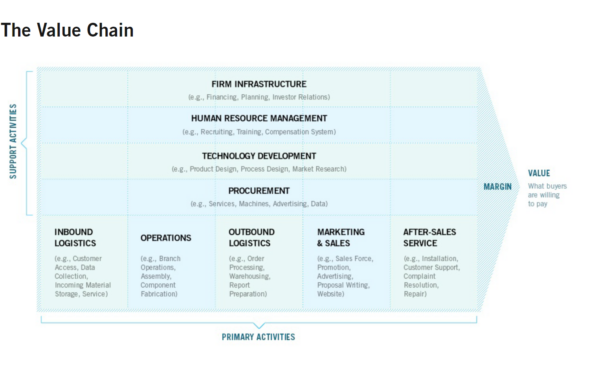Roundtable Recap: How communicators can take charge of change and become value creators
During a recent roundtable, Communications Leadership Council staff and select invitees explored how communicators can generate and demonstrate strategic value.

It’s hard to get a seat at the table when you don’t even have a spot on the value chain.
That’s one way to think about the challenge communicators face in being the strategic partners their businesses need to lead change across the enterprise.
On that note, Mary Buhay, Ragan’s chief growth officer and head of councils, kicked off an Oct. 16 roundtable discussion focused on how communicators can take charge of change to create value at Ragan’s Internal Communications Conference at Microsoft’s headquarters outside Seattle. The hourlong conversation sponsored by Ragan’s Communications Leadership Council included two dozen leaders across industries, from technology to manufacturing and professional and financial services.
“Communicators operate at the forefront of change,” Buhay said to roundtable participants, “and the role of the communicator is to bridge gaps in understanding and help to lead change, rather than be led by it.”
Highlights of that conversation are below. Note that participants were promised confidentiality so the insights from the conversation below are unattributed.
Communications and the strategic value chain
The concept of a strategic value chain has been used by businesses for more than three decades to diagram their sources of competitive advantage. But when you look at a common diagram (below), communications is nowhere to be found.
The reality is that communications is everywhere throughout the value supply chain but rarely seen in the traditional ways that companies assess value, Buhay said. That invisibility creates two distinct but related challenges for communicators:
- Shifting their functions to focus on value creation
- Demonstrating that value in business terms on an ongoing basis
Moving into the role of strategic advisor requires shutting down the drive-through window, order-taking mentality that has driven many communications organizations, Buhay said. Instead, communicators should focus on understanding how an organization creates value and driving the enterprise wide change that fuels growth.
Linking communications to value creation
The simplest value creation outcomes for communicators to focus on are trust and growth, one roundtable participant said. Trust is relatively easy alignment given the role the central role that effective communications plays in building culture and trust in leadership. Tying communications to growth is a tougher challenge.
Another roundtable participant noted that understanding of strategy is how they tie communications to growth. Rather than try to prove how communications directly ties to revenue or financial growth metrics, they focus on driving clarity and ensuring employees understand the organization’s strategy.
Another participant suggested connecting employee engagement to profitability and tying that to pipeline and financial metrics. That connection on the strategic value chain resonated with several roundtable participants, one of whom noted that measures of employee belonging and engagement can be correlated to employee retention. “The attrition rate is higher when engagement is lower,” they said.
Communication and culture are the two things that drive change, said another. Better culture aids recruiting and boosts brand reputation, and the resulting culture ambassadors can get the company’s name out in a positive way that boosts the bottom line.
Move from outputs to outcomes to demonstrate value
Linking communications tactics and strategy to how the organization creates value is one step in taking charge of change. The other is how to demonstrate that value.
Communicators commonly track and report channel-based metrics on employee communications such as newsletter opens, clickthroughs and engagement data on platforms like the intranet. Those numbers may be reported regularly to stakeholders, with additional outside metrics added such as employer scores on sites like Glassdoor and Indeed as well as employee Net Promoter Score, said one communicator.
But what is needed is to move from a focus on outputs to outcomes. Measurement efforts should be used to track toward value creation outcomes and employee behaviors that drive those outcomes. The transition starts with how communicators talk amongst themselves, said one senior communicator.
“If I hear team members talk about tactics, I redirect to talk about outcomes,” they said.
Roundtable attendees shared some of the ways they track outcomes. One way to measure elevated outcomes is to assess if employees and external audiences are picking up on new messaging. Another example is how internal communications efforts activate specific behaviors linked to firm objectives, such as employee adoption of generative AI or tools and processes that drive higher efficiency and better client service.
One roundtable participant noted that comms plays an important role in a key outcome linked to change management: driving understanding of strategy. Their organization is specifically aligning comms channels and initiatives to their enterprisewide strategy.
Be opportunistic to get the resources to drive change
Getting new resources comes down to influence, said one attendee. Every time they have an opportunity to address communications’ contribution to strategic value, they seize it. The nature of that conversation with leaders can vary, they said. Sometimes that counsel will be to do less, but they’re also willing to think through strategy and how the organization is going to create the context for change.
Leaders recognize that do this well will require resources, they said. It’s about being constantly in their ear to demonstrate how comms can help carry out their goals.
But it’s also important to be opportunistic and pick your spots. Going in and asking for more head count will more often than not shut a conversation down. Instead, identify where budgets are increasing and get creative, said another senior communicator. IT budgets are always growing so get good at taking a little sliver of it, they said.
To close the roundtable, Buhay said communicators can’t wait for permission. They need to actively explore how they deliver value and use that knowledge to guide what they say yes to, but also where and when they say no.
“The communicator’s natural habitat is at the frontier of change,” Buhay said to close the discussion. “How will you take charge of the change?”
Mike Prokopeak is director of learning and council content for Ragan’s Communications Leadership Council. Follow him on LinkedIn.
Ragan’s Communications Leadership Council offers an array of in-depth resources and networking opportunities for communications leaders. Learn more about joining here.







